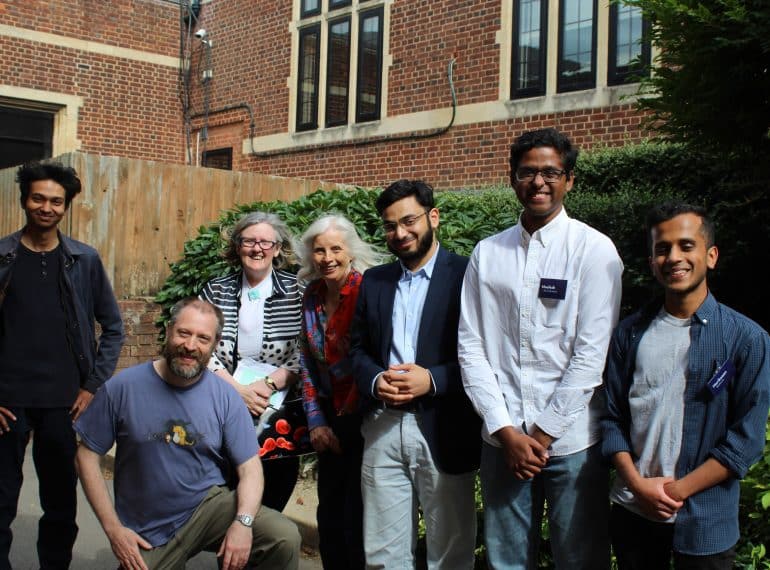
Old Elizabethans helped 50 boys battle it out in a Galactic Challenge at the School that saw all three teams secure multi-billion pound contracts for an imagined settlement in space.
The pupils from Years 7–9 (and from across tutor groups) formed aerospace ‘companies’ to participate in the space industry simulation challenge, competing against not only each other but also the clock. Their target was to design a space station for 100 years hence, when space travel might be commonplace. The remit was for a tourist resort that would orbit Mars.
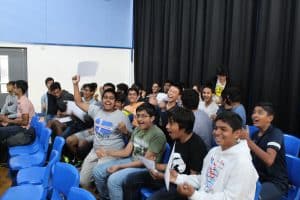 Lending their expertise and experience on the day were four 2017 leavers: Aadil Kara, Neelesh Ravichandran and Harikesan Baskaran and Suchira Peiris. Aadil, Neelesh and Harikesan all got through to the national stages of the UK Space Design Competition (Galactic Challenge’s ‘big brother’ for older pupils) when they were in Year 13, with Aadil going on to reach international level.
Lending their expertise and experience on the day were four 2017 leavers: Aadil Kara, Neelesh Ravichandran and Harikesan Baskaran and Suchira Peiris. Aadil, Neelesh and Harikesan all got through to the national stages of the UK Space Design Competition (Galactic Challenge’s ‘big brother’ for older pupils) when they were in Year 13, with Aadil going on to reach international level.
Jonathan Brooke, Head of Physics, has been impressed by how the OEs have sustained their commitment to STEM outreach throughout their undergraduate studies and beyond: “It’s even more impressive to see this commitment continue as they move into challenging careers and post-graduate study,” he said.
“They were the driving force behind digital Galactic Challenge competitions that were a welcome diversion to our boys during lockdown, and it was an honour and a pleasure to welcome them back to the School to host an in-person competition.”
Mr Brooke was also thanked the Year 12 boys who helped on the day. “Without them, the event could not have run so smoothly.”
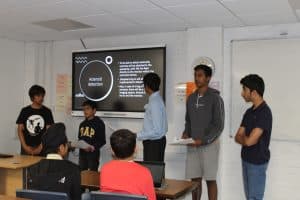 The challenge has two main objectives: to help foster pupils’ interest in Science, Technology, Engineering and Mathematics (STEM), and to help them develop so-called ‘soft skills’, such as team-working, communication, and the ability to solve complex problems.
The challenge has two main objectives: to help foster pupils’ interest in Science, Technology, Engineering and Mathematics (STEM), and to help them develop so-called ‘soft skills’, such as team-working, communication, and the ability to solve complex problems.
Aadil, who studied Physics at Imperial College London and now works as a data analyst for the Civil Service, said: “It was a joy to see the teams rise to the challenge, and to work productively in a way that rivals some professional teams!”
Harikesan, who is working towards a Master’s in Engineering for International Development at UCL, added: “The boys engaged within and outside their teams to produce some truly amazing designs. The fact that all teams won contracts is a testament to the quality of work produced across the board. Everyone really was a winner today!”
Neelesh now works as a technical analyst at Credit Suisse, having read Electrical & Electronic Engineering at Imperial College London. He said: “A brilliant amalgamation of strategy, engineering, science and public speaking skills – the Galactic Challenge was a joy to help with.”
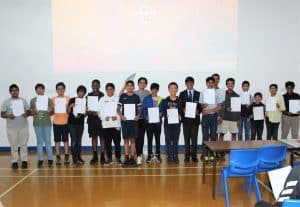 Suchira left QE to read Politics and International Studies at the University of Warwick, before securing a role as a consulting data analyst at the Information Lab. He said: “As a volunteer it was inspiring to see how engaged and active the students were in the competition, the out-of-the-box thinking, novel problem-solving and, in nearly every case, a board-worthy presentation!”
Suchira left QE to read Politics and International Studies at the University of Warwick, before securing a role as a consulting data analyst at the Information Lab. He said: “As a volunteer it was inspiring to see how engaged and active the students were in the competition, the out-of-the-box thinking, novel problem-solving and, in nearly every case, a board-worthy presentation!”
All four OEs commented on how much they had enjoyed being back at the School in person, observing that much had changed there in the past five years.
The three ‘companies’, Astrodyne Delta, Infinity Airspace and Solaris Flight Systems, were given a Request for Proposal (RFP) reflecting a typical design brief in the space engineering industry. They were asked to bid on a range of design modules: from the design of the command centre, to the power & energy generation, and the operations of the resort facility itself.
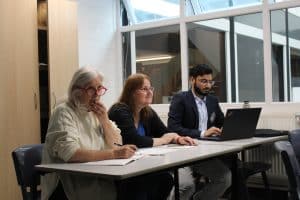 After trailing team Astrodyne Delta through the early stages of the competition, Solaris Flight Systems came through in the final stage to secure victory by the tightest of margins, winning contracts worth £320bn, against Astrodyne Delta’s £315bn. Infinity Airspace were not too far behind, on £300bn, with all three impressing the judges and securing contracts.
After trailing team Astrodyne Delta through the early stages of the competition, Solaris Flight Systems came through in the final stage to secure victory by the tightest of margins, winning contracts worth £320bn, against Astrodyne Delta’s £315bn. Infinity Airspace were not too far behind, on £300bn, with all three impressing the judges and securing contracts.
The judging panel comprised: Jenny Lyons, Director of Education at the Galactic Challenge; Alison Ahearn, Deputy Director of Education at the Galactic Challenge and Principal Teaching Fellow at Imperial College London; Headmaster Neil Enright; Gillian Ridge, Head of Biology; Tamara Rakviashvili, Science Technician, and Science teachers Bryn Evans, and J Murphy.
The designs were assessed in three stages over the day. Stages 1 and 2 were presented during the day to peers and judges, while Stage 3 was presented at the end of the day to parents, peers and the judging panel.
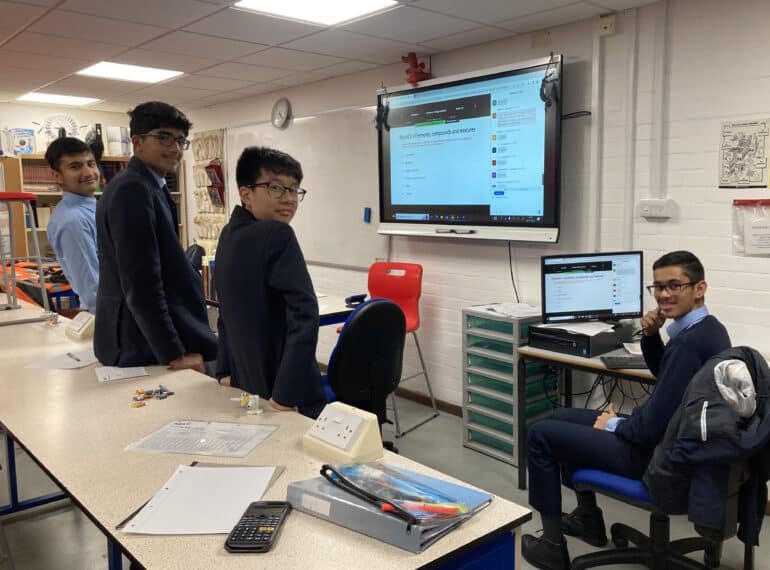
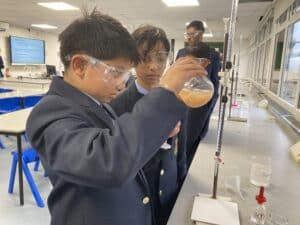 Team 38 (pictured top) scored 66 out of a maximum possible 72 – or 92% – to take first place ahead of St Benedict’s School, on 65 points, in the Chilterns and Middlesex round of the Top of the Bench competition.
Team 38 (pictured top) scored 66 out of a maximum possible 72 – or 92% – to take first place ahead of St Benedict’s School, on 65 points, in the Chilterns and Middlesex round of the Top of the Bench competition.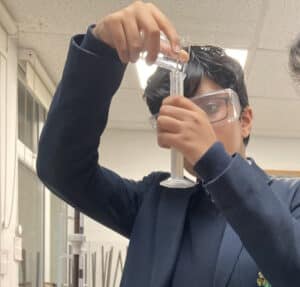 In addition to progressing to the national round of the competition in the spring, they win a silver shield and Amazon vouchers.
In addition to progressing to the national round of the competition in the spring, they win a silver shield and Amazon vouchers.
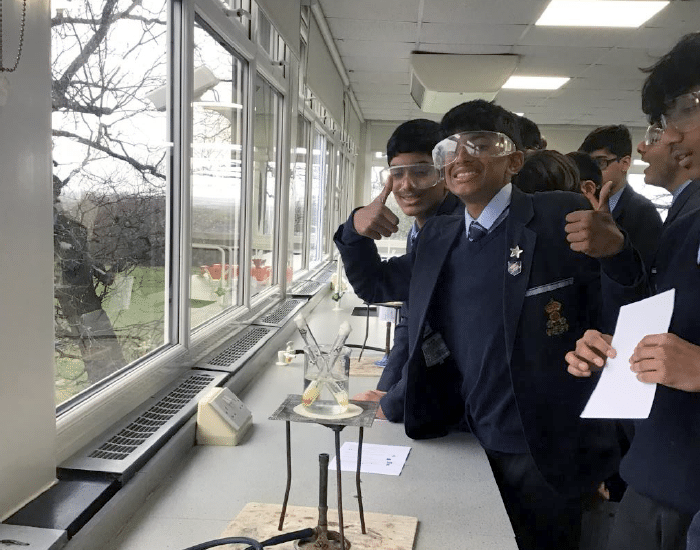
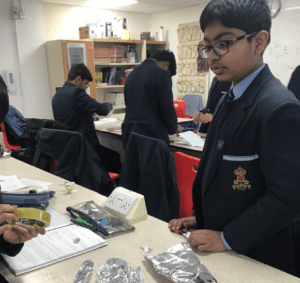 Year 8 boys conducted experiments to explore improvements in shipbuilding during Elizabeth I’s reign, to show how food was preserved in an age before refrigeration and to make their own Tudor-style soap.
Year 8 boys conducted experiments to explore improvements in shipbuilding during Elizabeth I’s reign, to show how food was preserved in an age before refrigeration and to make their own Tudor-style soap.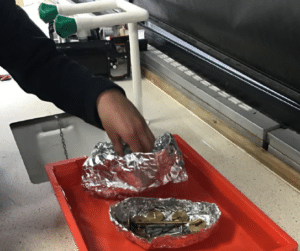 Another hands-on session involved making model boats out of aluminium foil to see which boat shape could hold the most mass. The boys learned that innovations by shipwrights during Elizabeth I’s reign allowed the introduction of ships that were faster, more manoeuvrable and carried heavier guns. The superiority of English ships was an important factor of the defeat of the Spanish Armada invasion fleet in 1588.
Another hands-on session involved making model boats out of aluminium foil to see which boat shape could hold the most mass. The boys learned that innovations by shipwrights during Elizabeth I’s reign allowed the introduction of ships that were faster, more manoeuvrable and carried heavier guns. The superiority of English ships was an important factor of the defeat of the Spanish Armada invasion fleet in 1588.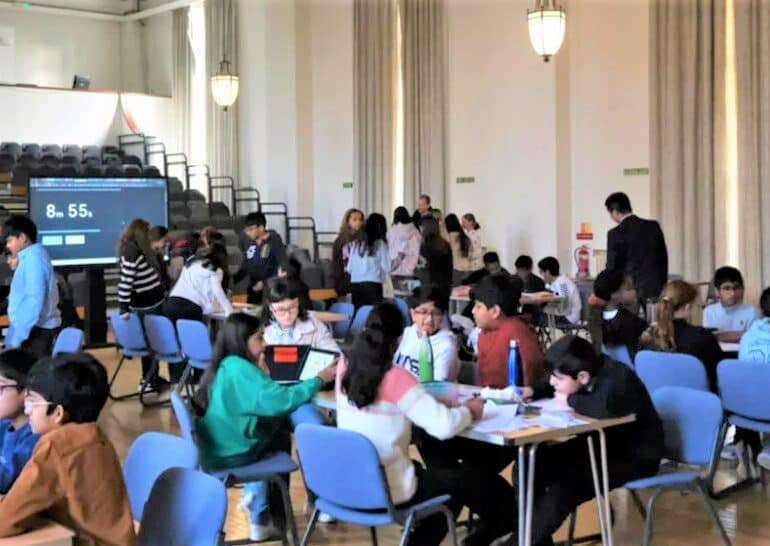
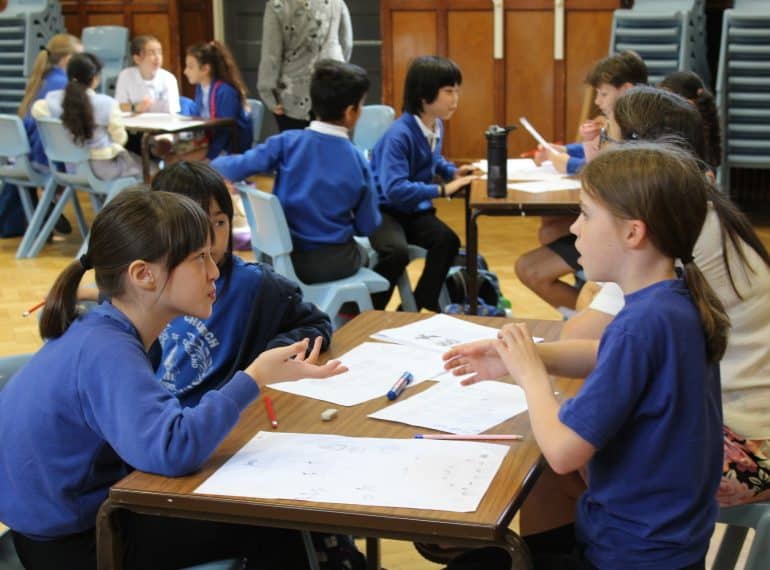
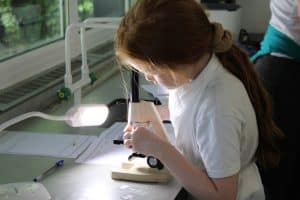 The events, which are part of QE’s partnerships work with the local community, are aimed at giving Year 5 girls and boys an early taste of secondary school education.
The events, which are part of QE’s partnerships work with the local community, are aimed at giving Year 5 girls and boys an early taste of secondary school education.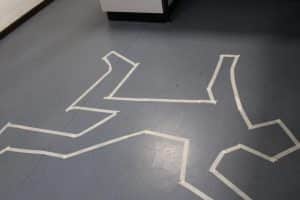 The first of the three days was the ever-popular Primary Forensics Workshop. The visitors were tasked with completing a number of experiments and analyses to work out who had murdered the Headmaster!
The first of the three days was the ever-popular Primary Forensics Workshop. The visitors were tasked with completing a number of experiments and analyses to work out who had murdered the Headmaster!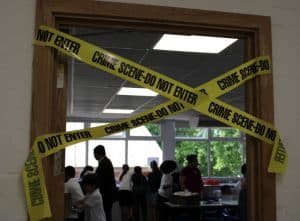 Boys from Year 12 helped staff run this workshop, engaging with the children at each station.
Boys from Year 12 helped staff run this workshop, engaging with the children at each station.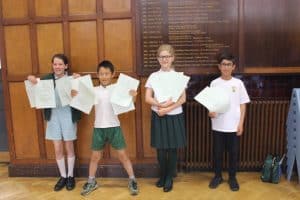 Firstly, teams were given the challenge of designing a castle on paper. They had to base their design on a certain set of criteria and follow a budget, requiring them to decide which features they wanted to prioritise.
Firstly, teams were given the challenge of designing a castle on paper. They had to base their design on a certain set of criteria and follow a budget, requiring them to decide which features they wanted to prioritise.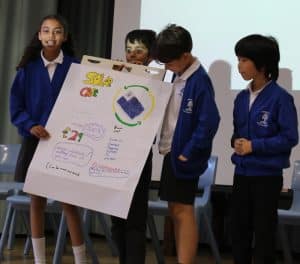 There was then a Sustainability Challenge run jointly by Geography and Economics. The children had to work in groups and devise a sustainable product. They designed their product, chose a logo and decided on their target market. Then each group presented to the other children in attendance. Among the ideas generated were: a mobile phone where the case is a solar panel and charges the phone, and a ‘plastic’ bottle where the bottle itself is biodegradable.
There was then a Sustainability Challenge run jointly by Geography and Economics. The children had to work in groups and devise a sustainable product. They designed their product, chose a logo and decided on their target market. Then each group presented to the other children in attendance. Among the ideas generated were: a mobile phone where the case is a solar panel and charges the phone, and a ‘plastic’ bottle where the bottle itself is biodegradable.
 Lending their expertise and experience on the day were four 2017 leavers: Aadil Kara, Neelesh Ravichandran and Harikesan Baskaran and Suchira Peiris. Aadil, Neelesh and Harikesan all got through to the national stages of the UK Space Design Competition (Galactic Challenge’s ‘big brother’ for older pupils) when they were in Year 13, with Aadil going on to reach international level.
Lending their expertise and experience on the day were four 2017 leavers: Aadil Kara, Neelesh Ravichandran and Harikesan Baskaran and Suchira Peiris. Aadil, Neelesh and Harikesan all got through to the national stages of the UK Space Design Competition (Galactic Challenge’s ‘big brother’ for older pupils) when they were in Year 13, with Aadil going on to reach international level. The challenge has two main objectives: to help foster pupils’ interest in Science, Technology, Engineering and Mathematics (STEM), and to help them develop so-called ‘soft skills’, such as team-working, communication, and the ability to solve complex problems.
The challenge has two main objectives: to help foster pupils’ interest in Science, Technology, Engineering and Mathematics (STEM), and to help them develop so-called ‘soft skills’, such as team-working, communication, and the ability to solve complex problems. Suchira left QE to read Politics and International Studies at the University of Warwick, before securing a role as a consulting data analyst at the Information Lab. He said: “As a volunteer it was inspiring to see how engaged and active the students were in the competition, the out-of-the-box thinking, novel problem-solving and, in nearly every case, a board-worthy presentation!”
Suchira left QE to read Politics and International Studies at the University of Warwick, before securing a role as a consulting data analyst at the Information Lab. He said: “As a volunteer it was inspiring to see how engaged and active the students were in the competition, the out-of-the-box thinking, novel problem-solving and, in nearly every case, a board-worthy presentation!” After trailing team Astrodyne Delta through the early stages of the competition, Solaris Flight Systems came through in the final stage to secure victory by the tightest of margins, winning contracts worth £320bn, against Astrodyne Delta’s £315bn. Infinity Airspace were not too far behind, on £300bn, with all three impressing the judges and securing contracts.
After trailing team Astrodyne Delta through the early stages of the competition, Solaris Flight Systems came through in the final stage to secure victory by the tightest of margins, winning contracts worth £320bn, against Astrodyne Delta’s £315bn. Infinity Airspace were not too far behind, on £300bn, with all three impressing the judges and securing contracts.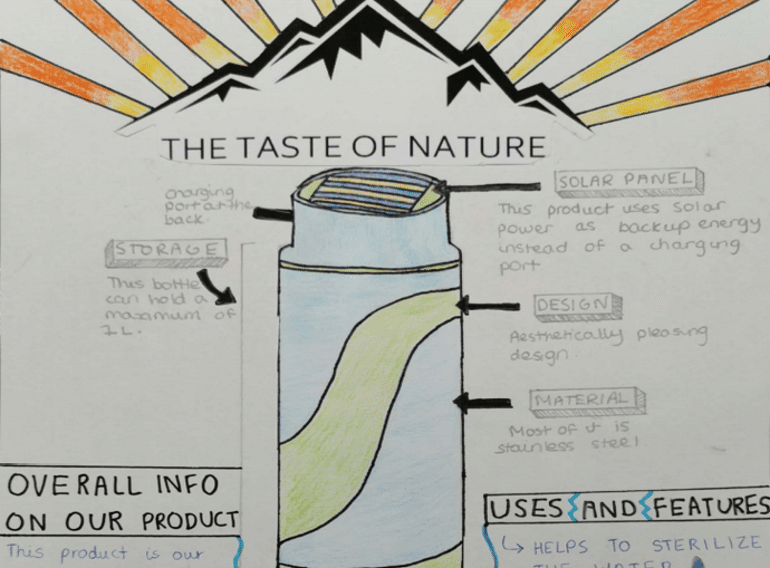
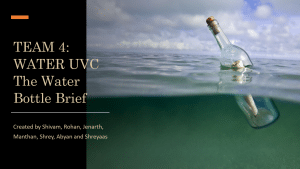 Team 4’s Water UVC bottle could thus benefit many millions across the developing world without access to safe drinking water, the boys explained in their richly illustrated, 31-page PowerPoint presentation. They even included an option for the UV lamp to be solar-powered to make the bottle viable for people who could not afford mains electricity.
Team 4’s Water UVC bottle could thus benefit many millions across the developing world without access to safe drinking water, the boys explained in their richly illustrated, 31-page PowerPoint presentation. They even included an option for the UV lamp to be solar-powered to make the bottle viable for people who could not afford mains electricity.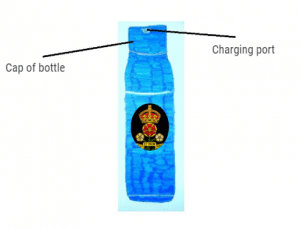 Making the announcement that Team 4 had won, Assistant Head (Pupil Progress) Sarah Westcott said: “During last term’s lockdown, our usual face-to-face careers activities for Year 9 in this important period of their School careers had to be reimagined. We amended our plans so that boys could work from home, while still developing important work-related skills such as creativity, teamwork, independence and the ability to communicate their ideas.”
Making the announcement that Team 4 had won, Assistant Head (Pupil Progress) Sarah Westcott said: “During last term’s lockdown, our usual face-to-face careers activities for Year 9 in this important period of their School careers had to be reimagined. We amended our plans so that boys could work from home, while still developing important work-related skills such as creativity, teamwork, independence and the ability to communicate their ideas.”